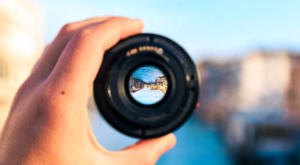Introduction:
A camera lens is the ‘eye’ of the camera and the lenses you choose have a big impact on the outcome of your photos. We think it’s a great idea to know how a lens works in order to advance your skills, even though it can be quite technical to begin with. For this reason, it’s useful to have camera lenses explained so that you understand how they affect the outcome of your photos, particularly if you’re just starting out.

Purpose of a lens:
Type of Lens what is it used for?
- 14mm – 35mm wide angle Landscape.
- architecture35mm – 85mm Standard Street travel.
- portrait85mm – 135mm Short telephoto Street photography and portraits135mm+ Medium telephoto Sports, wildlife action.
Types of lens:
The lens classification depends on how the light rays bend when they pass through the lens. The two main types of lenses are:
- Convex lens (converging).
- Convex lens (diverging).
Convex Lens:
This type of lens is thicker at the center and thinner at the edges. Optical lenses usually have two spherical lenses. If these surfaces curve outward, the lens is called a biconvex lens or simply convex lens.
Use of Convex Lenses in Cameras:
Convex lenses are commonly used in cameras to focus and magnify images. Almost all camera lenses contain a convex lens, a concave lens, and a biconvex lens. The first lens controls the magnification of the image by moving the image further away from or closer to the object. Use of convex lenses in daily life.
- Human eyes. The best example of convex lenses in daily life is that they help us see the world clearly before our eyes. ..
- Magnifier. …
- Glasses. …
- Camera. …
- Telescope. …
- Microscope. …
- Projector. …
- Multi-junction solar cells.
Concave Lens:
A concave lens is a lens that converts a straight ray of light from the light source into a reduced upright virtual image. It can create real and virtual images. Concave lenses have at least one internal curve.
Use of concave lenses in cameras:
Concave lenses are used in cameras, telescopes and camcorders to adjust the direction of the image formed by the convex lens and the chromatic aberration in the image. In general, it helps these optical devices to focus the images better. It is also used in flashlights to produce a wider beam of light.
- Concave Lens Uses.
- Concave Lens Used in Glasses.
- Uses of Concave Lens in Lasers.
- Use of Concave Lens in Cameras.
- Used in Flashlights.
- Concave Lens Used in Peepholes.
INSIDE VIEW OF ACAMERA LENS:
Camera lenses are made up of a number of lens elements (at least two, that are typically made from glass), which are arranged into various groups inside the lens casing. These lens elements are carefully designed by optical engineers to allow light to enter into the lens and hit the camera sensor, recording the image which you have composed. Each lens element is ground down to have a specific curve, with various curves being used such as biconvex, biconcave and so on. These all interact together to direct the light and the manner in which they are designed and arranged is responsible for how they transmit light and how good (or well controlled) the outcome is.
- Contrast – ideally we want a good degree of contrast in our images.
- Vegetating – this is where the corners of an image are darker than the middle.
- Sharpness – this is the amount of sharp details across the frame, which we want to be high.
- Distortion – there are various types of distortion which make an image appear less realistic and should be kept to a minimum.
- Focus breathing – this mainly affects video recording, with focus breathing appearing as zooming when focusing during video capture. Ideally this should be kept to a minimum. Wide-angle focal point:
A wide-angle focal point contains a central length of 35 mm or shorter, which gives you a wide field of see. The more extensive your field of view, the more of the scene you will be able to see within the outline.
These focal points are perfect for numerous scenarios and most picture takers have at least one trusty
Wide-angle focal point in their kit.Through the Glass: Exploring the Kaleidoscope of Camera Lenses:
Standard:
An ordinary focal point, moreover called a standard focal point, could be a focal point with a central length of between 35mm to 50mm. The central length of standard lenses are most comparable to how the human eye sees the world. Cinematographers regularly utilize typical focal points for more grounded, naturalistic cinematography.
Zoom:
A zoom focal point is, actually talking, a single focal point made up of numerous glass components, which can alter their viable point of see by moving certain elements inside the focal point as an entire. Through the Glass: Exploring the Kaleidoscope of Camera Lenses:












